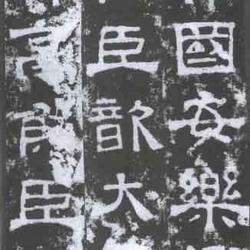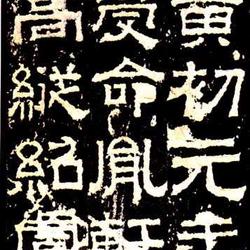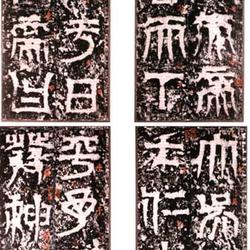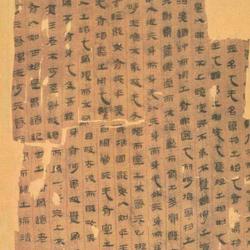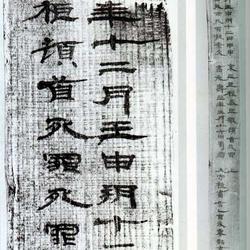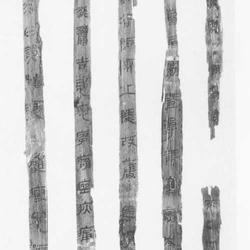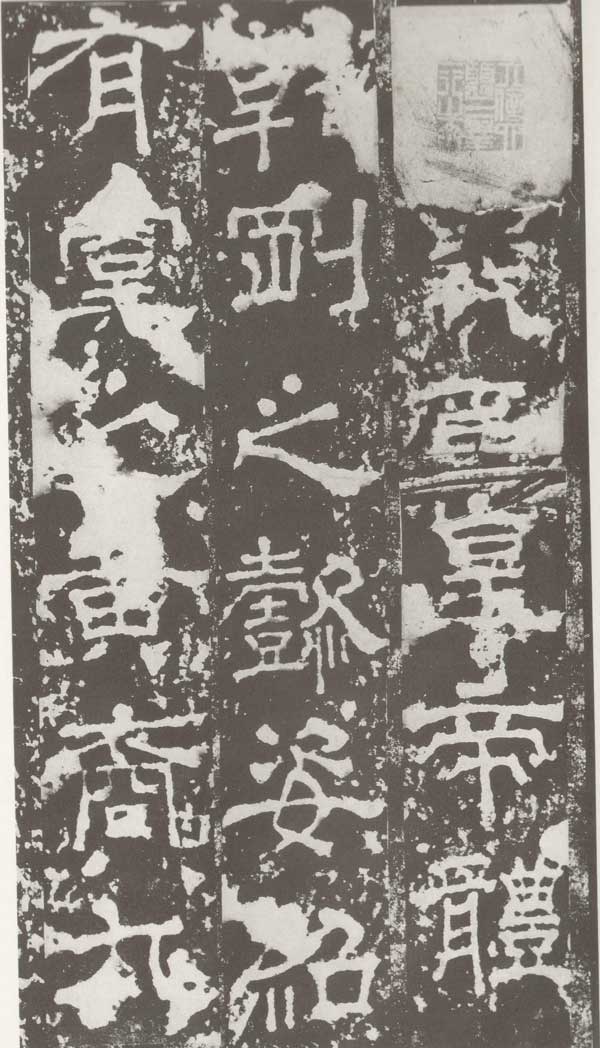
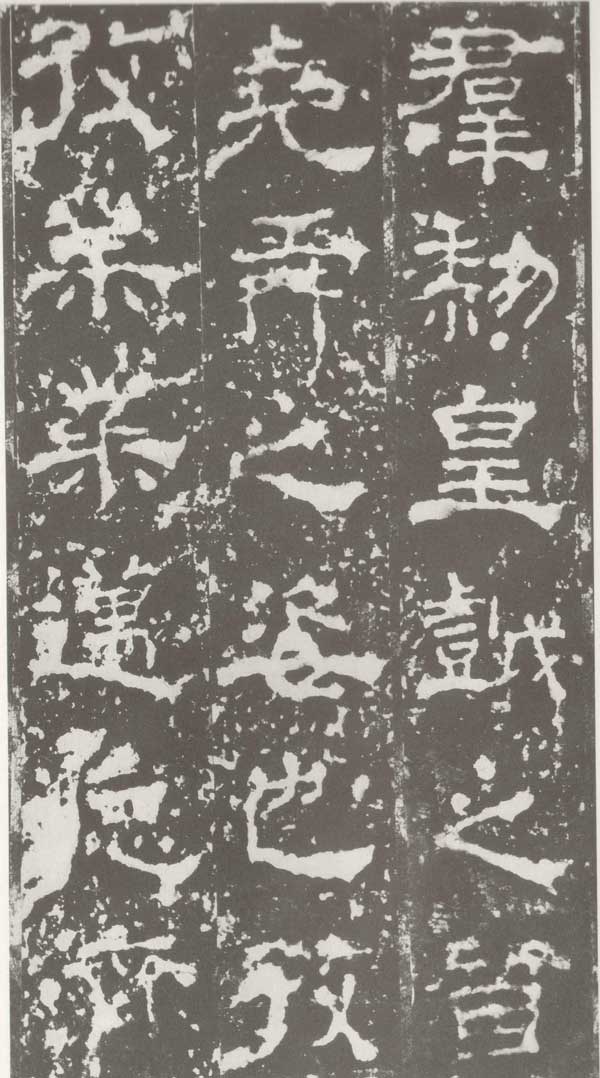
In the winter of the tenth month of the first year of Yankang (220), the first year of Emperor Xian of the Eastern Han Dynasty, Yi Mao was subordinated to Wei King Cao Pi. Pi immediately ascended the throne and proclaimed himself emperor and changed the Yuan Dynasty to the Great Wei Huangchu. At the end of October, this stele was erected to commemorate his acceptance of the "concession" of the Han Dynasty. "Biao of Receiving Zen" and the famous "Stele of Shangzun's Name" are erected side by side in the Han Xiandi Temple in the ancient city of Cao Wei in the south of Xuchang (the site is in today's Gucheng Village). The temple has been abandoned for a long time. "Shou Chan Biao" and "Shang Zun Hao Stele" were both made in the early Wei Dynasty. They not only have important historical value, but also have long-standing calligraphy. Therefore, they have been recorded repeatedly since the Tang and Song Dynasties. Its structure is square and neat, the brush strokes are strong and cutting, and the spirit is majestic and arranged, without losing the insightful and elegant style of famous steles in the late Han Dynasty, such as "Xi Ping Shi Jing", "Zhang Qian", "Li Qi", etc. Everyone’s style. Guo Zongchang of the Ming Dynasty commented in his "History of Jinshi" that "the calligraphy is the same as that of "Guan Jin". Although he is from a distant Han Dynasty, he is Yongyong and elegant, and his clothes and shoes are self-decorated, and he is also correct." Zhao Kan also said that this stele "is the same as "Guan Jin" in official law. "same". Wang Shizhen said: "....... Yu Shixi liked Emperor Ming's "Taishan Inscription", and suddenly felt lost when he saw this. The Han method is thin but strong, strong and tidy, unenthusiastic and boney; the Tang method is broad and fat, charming and slow, with less bones but more bones. State. The Han Dynasty was like Jian'an and Jin Sanxie. It was suppressed by the times, so it cannot be surpassed. This sentence is called the Samadhi of Commentary." ("Graphite Engraved Hua") From the perspective of the evolution of Chinese character fonts, the period of the late Han Dynasty and the early Wei Dynasty was The transitional period from official to regular script. The carvings of the early Wei Dynasty inherited the legacy of the Xiping Stone Classics, Xian Yuhuang, and Zhang Qian of the late Han Dynasty, and made new breakthroughs in brushwork. The specific manifestation is that the backstroke of writing is reduced and changed to a straight line; the stroke is quickly lifted after a heavy pause to form a square wave. This is already a special writing method of regular script in its embryonic period. Predecessors have discussed this a lot. For example, Sun Kuang of the Qing Dynasty commented on "Shou Zen Biao" and "Shangzunhao Stele": "I have the same two steles. Although they are very worn, the characters are still half legible, which is really decisive. ... The correction of the book is dangerous. Many methods have been changed since then." Yang Shoujing's "Xue Shu Yi Yan" is also called "Kong Xian", "Paradigm", "Shang Zun Hao", and "Shou Zen Biao" "The writing is like a folding knife head, and the character is sharp, so it is the true name of the Six Dynasties. The ancestor of calligraphy." The slightly later "Wang Ji Stele" of Wei Dynasty and "Gu Lang Stele" of Wu Dynasty further developed this "folding knife head" writing method, and the glyphs are more similar to the regular script of later generations. Therefore, it is undoubtedly true that the predecessors said that this stele was the first regular script in the Wei, Jin and Six Dynasties. There is no name of the person who wrote this stele. Liu Yuxi of the Tang Dynasty said that it was written by Wang Lang, Liang Hu wrote the elixir, and Zhong Yao engraved it. It is known as the "three wonders" in the world (see Tang Wei Xuan's "Liu Binbin's Jiahua"). Yan Zhenqing thought that Zhong Yao wrote it (see "Ji Gu Lu" by Ouyang Xiu of Song Dynasty and "Han Li Ziyuan" by Lou Ji), but there is no solid evidence for both theories, so they are not credible.
Reminder:
Guo Zongchang of the Ming Dynasty: The calligraphy is the same as that of "Encouraging Advancement". Although he is from a distant Han Dynasty, he is Yongyong and elegant. His clothes and shoes are decorated by himself, and he is also corrected. ("History of Epigraphy")
Wang Shizhen of the Qing Dynasty: Yu Shixi read Emperor Ming's "Taishan Inscription". Seeing this, he suddenly felt lost. The Han method is thin, strong and tidy, unsympathetic but bony, while the Tang method is wide and fat, charming and slow, less boney and multi-faceted. The Han Dynasty was like Jian'an, Jin Sanxie, and was suppressed by the times, so it cannot be surpassed. This statement is worth commenting on. ("Graphite Engraving")
Yang Shoujing, Qing Dynasty: His writing style is like the head of a folding knife, and his character is sharp, so he is the ancestor of true calligraphy in the Six Dynasties. ("Xue Shu Yi Yan")
Kang Youwei of the Qing Dynasty: At that time, Wei Jinghou came out. He was as famous as Handan in ancient writing and his handwriting was proficient. Today, the remaining writings of "Shou Zen Biao" exist alone. The owl watches the tiger, and it is majestic. ("Guangyi Zhou Shuangji")

